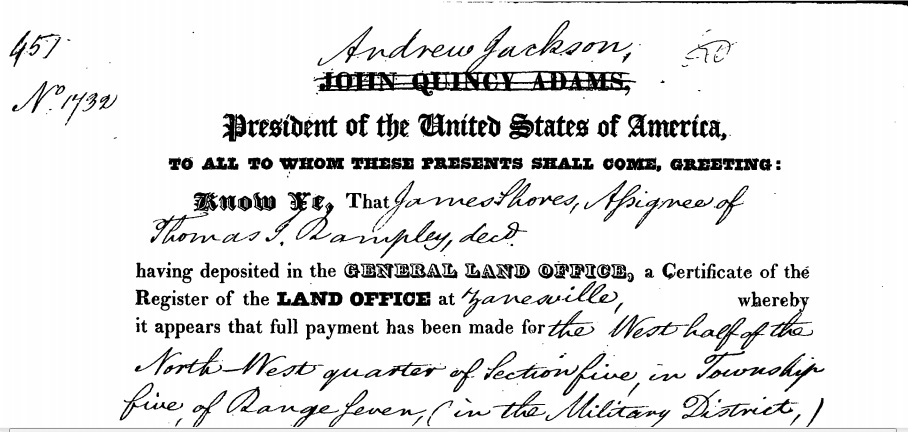It is all about how things are ordered and how people are described.
There are two deeds in the “Complete ‘Credit Under’ Land Entry of James Shores, assignee of Thomas J. Rampley” of Coshocton County, Ohio. Both are dated 21 April 1829. One transfers interest in the patent from Thomas Tipton to James Shores. The other transfers title in the patent from James Shores, Administrator of the Estate of Thomas J. Rampley, deceased, to Thomas Tipton. Both list the same property (part of section 5 in what is now Jackson Township, Coshocton County, Ohio) that is described in Thomas J. Rampley’s “Complete ‘Credit Under’ Land Entry.” Copies of both deeds are contained in the records of the complete claim file at the National Archives.

Part of the patent to James Shores obtained on the Bureau of Land Management website
Why are there two deeds that are seemingly parallel?
There’s a reason and the reason is that the deeds are not parallel. They also need to be viewed in the proper order. Both are dated the same date, but one was executed first–the one from James Shores.
The thing is, it was not James Shores who really executed the deed. It was James Shores in his capacity as administrator of the estate of Thomas J. Rampley who deeded the equitable interest in the land claim to Thomas Tipton. Then, Tipton immediately deeded that interest to James Shores in his own right. This was not done to confuse researchers nearly 200 years later.

part of the 21 April 1829 deed from Thomas Tipton to James Shores, obtained in the “Completed “credit under” Land Entry” of James Shores, assignee of Thomas J. Rampley; National Archives
It was done to keep the title clean and appease the General Land Office. It would have looked odd if Thomas Shores as administrator had deeded the land to himself, particularly since there were heirs of Thomas Rampley who had an interest in the property upon his death. And there were heirs: Thomas’ widow, Christianna, and several children–including the wife of James Shores.
Tipton was what is referred to as a “straw man.” The intent was never to have him actually own the property in question. The deed to him and the deed from him served to clearly give Shores title and document the payment.
The order of the deeds matters–the deed from Shores was first. The description of Shores matters as well–words like “administrator” are not thrown around in documents willy-nilly.

No responses yet